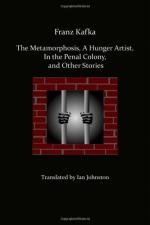|
This section contains 3,873 words (approx. 13 pages at 300 words per page) |

|
SOURCE: "A Hunger Artist: Content and Form," in American Imago, Vol. 35, No. 4, Winter, 1978, pp. 357-74.
In the excerpt below, Mahony analyzes Kafka's literary technique in "A Hunger Artist" and provides a psychoanalytic interpretation of the story.
In a recent book on applied psychoanalysis, two critics have rightly said that "Kafka's 'A Hunger Artist' is perhaps one of the most powerful, perfectly told tales ever written" [Morton Kaplan and Robert Kloss, "Fantasy of the Devouring Killer: Kafka's A Hunger Artist," in The Unspoken Motive: A Guide to Psychoanalytic Criticism, 1973]. Most of the power of Kafka's story, I would add, comes from the author's technique of broadening levels of meanings, establishing a continuum among those levels, and subjecting them to many reversals in the literary and psychoanalytic sense of the term. A clarification of Kafka's technique of inclusivity and expansiveness brings to light other dimensions affected by his utilization of...
|
This section contains 3,873 words (approx. 13 pages at 300 words per page) |

|


